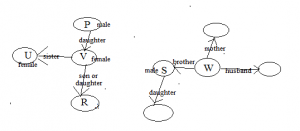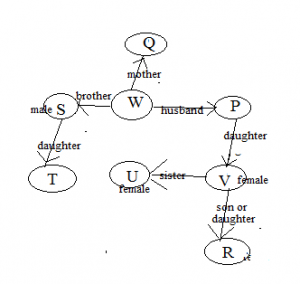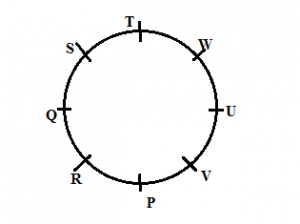Hello Aspirants. Welcome to Online Reasoning Section in AffairsCloud.com. We are providing Free IBPS Clerk course 2015 and creating sample questions in Reasoning, the type of which will be asked in IBPS Clerk Prelims Exam.
Stratus – IBPS Clerk Course 2015

[flipclock]
Directions (Q. 1-5): Study the following information to answer the given questions:
There are 8 people in a family – P, Q, R, S, T, U, V and W are sitting around a circle facing the centre but not necessarily in the same order. All people have relation with other people.
Q sits second to left of W’s husband. No female is an immediate neighbor of Q. S’s daughter sits second to right of U. U is the sister of V. U is not an immediate neighbor of W’s husband.
Only one person sits between P and U. P is the father of V. W’s brother S sits to the immediate left of W’s mother. Only one person sits between W’s mother and T. Only one person sits between W and V. V is the mother of R. V is not an immediate neighbor of T.
Explanation:
First try to make the relationship among all people.

As seen in figure, we get 2 diagrams. Since all people have relationship with one another, in this P can be W’s husband only.
And since given that only one person sits between W’s mother and T, this means W’s mother is not T, so S’s daughter is T. This gives

Now make the seating arrangement diagram.

- Who sits second to the left of W?
A) T
B) V
C) S
D) W
E) RB) V - Who sits opposite Q?
A) T
B) W
C) U
D) V
E) PC) U - What is the relation of W with V?
A) Grand Mother
B) Aunt
C) Uncle
D) Mother
E) None of theseD) Mother - Four of the five are alike in a certain way. Which does not belong to the group?
A) V
B) Q
C) T
D) P
E) UD) P
Explanation:
All are females except P - Which of the following is true regarding R?
A) R is an immediate neighbor of U.
B) R’s opposite sits U
C) Q sits third to the left of R
D) R sits exactly between P and Q
D) R sits exactly between P and VD) R sits exactly between P and Q
Directions (Q. 6-10): In the following questions, the symbols * , $, #, δ and % are used with the following meaning as illustrated below:
‘P $ Q’ means ‘P is neither greater than nor smaller than Q’.
‘P δ Q’ means ‘P is neither greater than nor equal to Q’.
‘P % Q’ means ‘P is neither smaller than nor equal to Q’.
‘P*Q’ means ‘P is not smaller than Q’.
‘P # Q’ means ‘P is not greater than Q’.
Now in each of the following question assuming the given statements to be true, find which of the conclusions I, II, III and IV given below them is/are definitely true and give your answer accordingly.
- Statements: D * K, K % T, T δ R, R # M
Conclusions:
I. M % T
II. D %T
III.R % K
IV.M # D
A) Only I is true
B) Only II is true
C) Only I and II are true
D) Only II and III are true
E) None of theseC) Only I and II are true
Explanation:
D ≥ K > T < R ≤ M - Statements: F δ W, W $ V, V % B, B * D
Conclusions:
I. F δ B
II. D δ V
III. V % F
IV. W%D
A) Only I is true
B) Only I, II and III are true
C) Only I, II and IV are true
D) Only II, III and IV are true
E) None of theseD) Only II, III and IV are true
Explanation:
F < W = V > B ≥ D - Statements : Z % N, N # K, K $ M, M δ R
Conclusions:
I. M $ N
II. M % N
III.R % N
IV. Z % M
A) Only either I or II and III are true
B) Only either I or II is true
C) Only either I or II and III and IV are true
D) Only III is true
E) None of theseA) Only either I or II and III are true
Explanation:
Z > N ≤ K = M < R N ≤ K = M gives either M = N or M > N - Statements : F # K, K $ T, D % T, V * D
Conclusions:
I. T * F
II. D % K
III. D % F
IV. V % K
A) Only I and II are true
B) Only I, II and III are true
C) Only II and III are true
D) Only II, III and IV are true
E) All are trueE) All are true
Explanation:
F ≤ K = T < D ≤ V gives all conclusions as true - Statements : H $ J, J δ Y, Y * K, K # W
Conclusions:
I. W % Y
II. K δ J
III. K # H
IV. H δ W
A) None is true
B) Only I is true
C) Only II is true
D) Only III is true
E) Only IV is trueA) None is true
Explanation:
H = J < Y ≥ K ≤ W gives
No relationship between W and Y
No relationship between K and J
No relationship between K and H
No relationship between H and W


